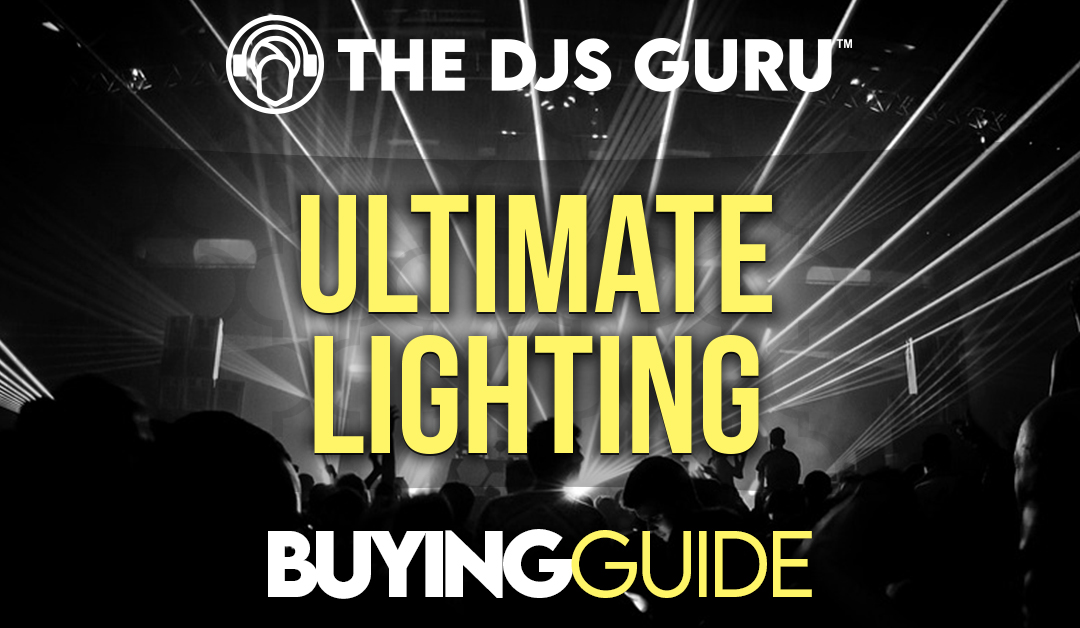This article is an excerpt from my book “The Essential Guide to Building a Mobile DJ Light Show“. Check out the full book for yourself by clicking here.
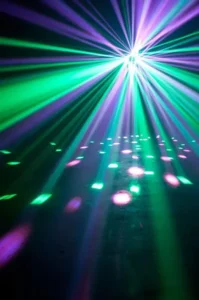
But just like speakers or controllers, the market for DJ lighting is HUGE. There are literally hundreds of options and a whole new glossary of terms to learn. What’s a lumen? A gobo? How exactly does a light wash something? In this DJ lighting buying guide, we’re going to break down the different types of lighting available to DJs and some important specs to consider when picking up a new light or two (or two dozen).
For help on lighting and a curated selection of items, check DJSupplyStore.com
Where to start?
The biggest mistake you can make when building a light show is buying purely on looks. Most DJs simply see a light online or at a show that they think looks cool and buy it without a second thought. However, different DJ lights serve different purposes. Depending on the type of event you do, one style of lighting may work much better than another. Let’s start off this DJ lighting buying guide by talking about some of the many styles of DJ lights and what they’re best used for.
Wash Lighting
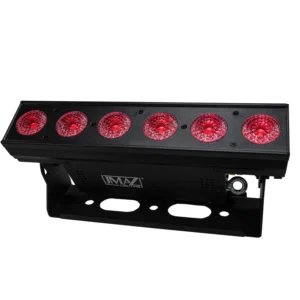
Regardless of the shape, wash lighting is responsible for filling an area with light. Using good wash lighting allows you to turn off the venue’s overhead lighting and create an atmosphere conducive to partying and socializing. All of the effect lights in the world won’t make up for a fluorescent-white-filled ballroom that turns people off from getting out of their chairs. Because of this, wash lighting should be the base of any light show. It doesn’t matter if you’re a wedding DJ or a school DJ – start with wash lights.
Best applications: Weddings, school dances, private events, corporate events
For help on lighting and a curated selection of items, check DJSupplyStore.com
Moving Heads/Scanners
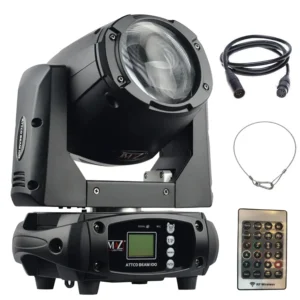
If you’ve been to a large concert or tour you’ve definitely seen long lines of moving heads running across the stage trusting. Both moving heads and scanners were previously reserved for big-budget productions due to their large size and cost. Nowadays, however, they have become significantly more compact and affordable.
A professional look
Because of their association with professional productions, moving heads lend a certain authority to your light show. Moving heads can do anything from slow, elegant sweeps across a room to fast, high-energy figure 8s. They can spotlight a speaker or first dance. Depending on your preference, they can run automatic programs or be controlled via a DMX controller. They can be hung from a lighting stand or set on a table or totem.
Because of their versatility and modern effect, they make a perfect addition to a DJs light show after some wash lighting. While they usually cost a bit more than simpler effect lights, their effect is well worth the price increase. When buying moving heads, they almost always look best in pairs or sets of even numbers.
Best applications: Weddings, corporate events, fashion shows, school dances, private events
For help on lighting and a curated selection of items, check DJSupplyStore.com
Uplights
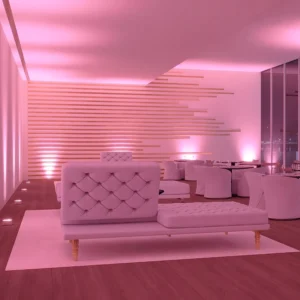
For events like weddings, uplights are usually set on a single static color to create ambiance in a space. Once the dancing starts, they can be changed to a more exciting color-changing program. They can be set to fade slowly or jump quickly between colors. They can also function as strobe lights. While simple in concept, uplights can have a big impact on the look of a venue.
Best applications: Weddings, corporate events
For help on lighting and a curated selection of items, check DJSupplyStore.com
Effect Lighting
Effect lighting can take on many forms. Classic effect lights include the likes of moonflowers, disco balls, lasers, strobes, beams, and more. The effect lighting category is difficult to define, simply because it contains so many types of fixtures. 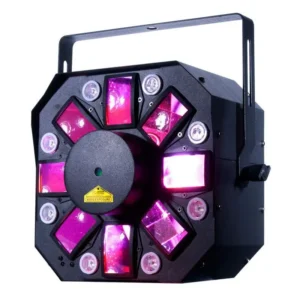
If you do decide to add some effect lighting to your show, find ways to use it creatively. Turn the lights on and off periodically throughout the event. Aim the effects at the ceiling or floor instead of directly at the audience. Buy lights in pairs to bring symmetry to your setup.
Best applications: Sweet 16s, private events, school dances
For help on lighting and a curated selection of items, check DJSupplyStore.com
DJ Lighting Buying Guide – Lighting Specs
Up to this point, we’ve discussed each of the most common DJ lighting types briefly and explained what each is best used for. But even when you decide to pick up, let’s say, some wash lighting, you still have to sort through dozens and dozens of possible options. This is where knowing a few specifications is going to come in handy. Let’s walk through a handful of important terms and how you can use each one to choose the best lighting for your company.
LUMENS/LUX
This is probably the single most important spec to pay attention to. The lumens or lux value tells you how bright the light is. The higher this number, the brighter the light. It is usually measured at a stated distance, such as 1 or 2 meters. When comparing two lights, make sure you are comparing their brightness at the same distance.
WATTS/POWER CONSUMPTION
This is NOT a measure of brightness (although many DJs think it is). It is simply a measure of how much power the light pulls from the wall. If you are running many lights at once it may be important so that you don’t trip a breaker, but most mobile DJs won’t even get close to using that much power.
LED TYPE
Most lights that DJs are buying use LED diodes to produce lights. Bulbs have phased out of popularity due to their bigger power consumption, duty cycles, and heat generation. While lamps and bulbs have a place in very large, professional fixtures, most people are using LEDs in their DJ lights. Not all LEDs are created equal, especially when it comes to color. LED diodes can be single color, RGB (red, green, blue), RGBW (white added), RGBWA (white and amber added), or hex (white, amber, and ultraviolet added). The more colors in your diode, the more colors you can create and the richer those colors will be.
BEAM ANGLE
For lights that project a beam of light, like moving heads, the beam angle is important. The beam angle is how wide the light will spread out when it leaves the lens of the fixture. Narrow beam angles create sharp, small beams of light and are seen in moving heads and spot lights. Wide beam angles are found in wash lighting. Many moving heads have adjustable beam angles for increased versatility.
GOBO/COLOR WHEELS
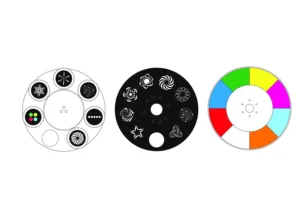
DMX CONTROL
If you want to take control of your light, you’ll most likely have to use DMX. DMX is the programming language of lighting and it allows you to control things such as color, brightness, beam angle, gobo, and more. The specs for a specific light should tell you a) if the light is DMX controllable and b) how many channels the light has available. The more DMX channels, the more ways you can control the light. A simple light may have 3 channels to control the intensity of red, green, and blue. A complicated moving head may have 20 channels for direction, speed, brightness, color, gobo, fading, and more.
BATTERY POWER
This is more of a bonus specification. While not every light you buy will have battery power, more and more lights these days are rechargeable. What does this mean for you? Fewer wires, easier setup, and quicker tear down at the end of the gig. The majority of battery-powered lights you’ll find are uplights or wash lights. The most important part of this spec? How long that battery lasts on a full charge!
DJ Lighting Buying Guide – Wrapping it all up
Whew! You made it! Hopefully, this ultimate DJ lighting buying guide has helped you gain a better understanding of the different types of DJ lights available and how to pick the best ones for your company. Take a look at pictures from DJs you admire or companies in your area. What are they doing that’s working well? How can you be inspired by what others are doing and make it your own? Are there unique ways you can use lighting to enhance your events? Whether you’re a brand new DJ or perhaps just someone that missed the lighting boat the first time around, this guide should get you started on the right foot when it comes to choosing DJ lighting.
For help on lighting and a curated selection of items, check DJSupplyStore.com

